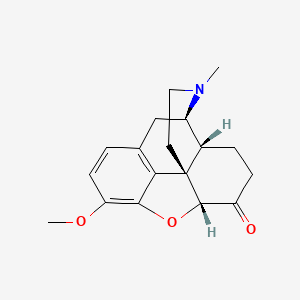NCBI Bookshelf. A service of the National Library of Medicine, National Institutes of Health.
LiverTox: Clinical and Research Information on Drug-Induced Liver Injury [Internet]. Bethesda (MD): National Institute of Diabetes and Digestive and Kidney Diseases; 2012-.

LiverTox: Clinical and Research Information on Drug-Induced Liver Injury [Internet].
Show detailsOVERVIEW
Introduction
Hydrocodone is a semisynthetic, moderately potent, orally available opioid that, in combination with acetaminophen, is widely used for treatment of acute or chronic pain, and in combination with antihistamines or anticholinergics used to treat cough. Hydrocodone by itself has not been linked to serum enzyme elevations during therapy or to clinically apparent liver injury, but the combination with acetaminophen has been linked to many cases of acute liver failure due to unintentional overdose with acetaminophen.
Background
Hydrocodone (hye” droe koe’ done) is a semisynthetic derivative of codeine or thebaine, natural alkaloids derived from the resin of poppy seeds (Papaver somniferum). It is well absorbed orally and has moderate opiate activity (approximately 6 times that of codeine), acting an agonist of the µ opiate receptor. The combination of hydrocodone with acetaminophen is effective in ameliorating moderate-to-moderately severe pain and is widely used for temporary as well as chronic management of pain states. The combination of hydrocodone with acetaminophen or other products helps to prevent its recreational use and administration by injection. Hydrocodone has been in use since shortly after its initial synthesis in the 1920’s, but was formally approved for use in combination with acetaminophen in the United States in 1998. Current indications are for treatment of moderate-to-moderately severe pain (combinations with acetaminophen or ibuprofen) or alleviation of cough and symptoms of upper respiratory tract infections (combined with chlorpheniramine or homatropine). It is currently one of the most commonly prescribed drugs in medical practice. Hydrocodone is available in multiple formulations (tablets, capsules, syrup) combined with other analgesics, antihistamines or anticholinergics in concentrations of 2.5, 5, 7.5 and 10 mg generically and (with acetaminophen) under brand names such as Vicodin, Norco, Lortab and Co-Gesic, among others. The preparations are generally taken every 4 to 6 hours. Importantly, the dose of acetaminophen in hydrocodone combinations varies from 300 to 1000 mg per tablet. The FDA, however, has recommended that physicians not use opioid combinations with concentrations of acetaminophen of more than 325 mg per unit dose. Side effects of hydrocodone include sedation, respiratory depression, mental clouding, euphoria, agitation, constipation, diarrhea, abdominal bloating, nausea, vomiting, headache and dizziness. Severe adverse events include life-threatening respiratory depression, addiction, abuse, opioid withdrawal, serotonin syndrome (when used with serotonergic agents) and adrenal insufficiency. Hydrocodone is a controlled substances and classified as a Schedule III drug, indicating that it has medical usefulness, but also a potential for physical and psychological dependency and abuse.
Hepatotoxicity
Despite wide scale use for many decades, hydrocodone by itself has not been convincingly linked to instances of clinically apparent acute liver injury. However, when combined with acetaminophen, hydrocodone combinations have become a common cause of acetaminophen acute liver injury. The typical history is of a patient who began taking more than the prescribed number of pills over several days, attempting to achieve more of an opiate effect and leading secondarily and unintentionally to an overdose of acetaminophen. Because of their potential for hepatotoxicity, opioid combinations in which the dose of acetaminophen is greater than 325 mg per tablet or capsule were discontinued.
Hydrocodone, like other opiates, is metabolized in the liver by the P450 microsomal oxidizing enzyme system, and levels can be significantly affected by either inhibitors of CYP 3A4 (which increase levels and can lead to toxicity) or inducers of the enzyme (which decrease levels and can affect efficacy).
Likelihood score: E (unlikely cause of clinically apparent liver injury).
References on the safety and potential hepatotoxicity of hydrocodone are given in the Overview section of the Opioids.
Drug Class: Opioids
PRODUCT INFORMATION
REPRESENTATIVE TRADE NAMES
Hydrocodone (with Acetaminophen) – Generic, Co-Gesic®, Vicodin®
DRUG CLASS
Opioids
Product labeling at DailyMed, National Library of Medicine, NIH
CHEMICAL FORMULA AND STRUCTURE
| DRUG | CAS REGISTRY NO. | MOLECULAR FORMULA | STRUCTURE |
|---|---|---|---|
| Hydrocodone | 125-29-1 | C18-H21-N-O3 |

|
- PubChem SubstanceRelated PubChem Substances
- Review Opioids.[LiverTox: Clinical and Researc...]Review Opioids.. LiverTox: Clinical and Research Information on Drug-Induced Liver Injury. 2012
- Review Oxycodone.[LiverTox: Clinical and Researc...]Review Oxycodone.. LiverTox: Clinical and Research Information on Drug-Induced Liver Injury. 2012
- Opioid-related overdose and chronic use following an initial prescription of hydrocodone versus oxycodone.[PLoS One. 2022]Opioid-related overdose and chronic use following an initial prescription of hydrocodone versus oxycodone.Weiner SG, Hendricks MA, El Ibrahimi S, Ritter GA, Hallvik SE, Hildebran C, Weiss RD, Boyer EW, Flores DP, Nelson LS, et al. PLoS One. 2022; 17(4):e0266561. Epub 2022 Apr 5.
- Review Pharmacokinetic evaluation of hydrocodone/acetaminophen for pain management.[J Opioid Manag. 2013]Review Pharmacokinetic evaluation of hydrocodone/acetaminophen for pain management.Singla A, Sloan P. J Opioid Manag. 2013 Jan-Feb; 9(1):71-80.
- Efficacy and safety of once-daily, extended-release hydrocodone in individuals previously receiving hydrocodone/acetaminophen combination therapy for chronic pain.[Postgrad Med. 2015]Efficacy and safety of once-daily, extended-release hydrocodone in individuals previously receiving hydrocodone/acetaminophen combination therapy for chronic pain.Bartoli A, Michna E, He E, Wen W. Postgrad Med. 2015 Jan; 127(1):5-12. Epub 2014 Dec 16.
- Hydrocodone - LiverToxHydrocodone - LiverTox
Your browsing activity is empty.
Activity recording is turned off.
See more...